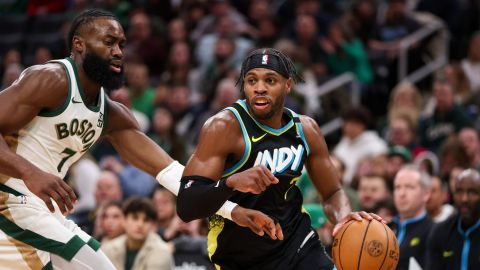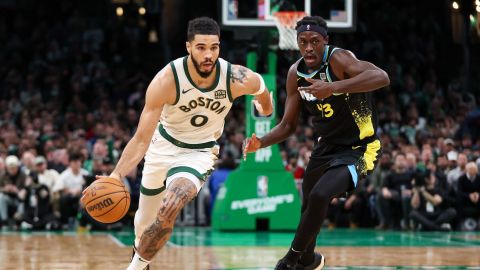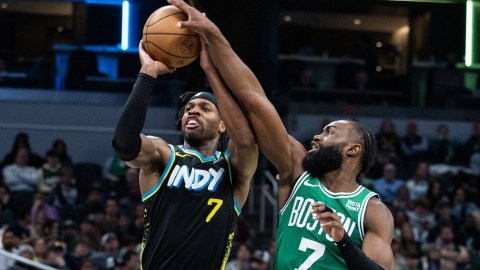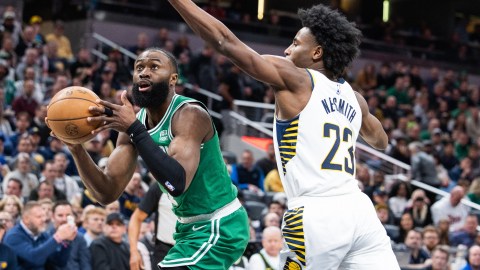 Paul George intends to be in Indiana for a long time, and the Pacers should be fine with that.
Paul George intends to be in Indiana for a long time, and the Pacers should be fine with that.
With George declaring confidently that a long-term contract with the team is “going to get done” before the season begins, it seems like a no-brainer that the budding All-Star and last year’s most improved player will get the five-year, “designated player” extension with the Pacers. Hardly anyone completely hates the move, particularly after George’s national coming-out party in the Eastern Conference finals last spring.
As intoxicating as George’s physical skills are and as admirable as it is to see a player who dedicates himself to defense as much as his scoring output, signing the 23-year-old swing-forward is not without risks. Honestly, the Pacers can’t afford not to give George a maximum extension, but they are far from the first team to be in this situation.
Everyone loves George. That is not much of an exaggeration. One columnist paused to give Pacers fans a moment to “let out one joyful scream” after telling them George is likely to re-sign. Coaches love his work ethic. Teammates love his complementary game. Reporters love his unassuming personality. Opponents — the good ones, anyway — love the competition he offers. Analytics guys love his efficiency ratings. Traditionalists love all of the above, except the statistical stuff.
Before George’s deal gets rubber-stamped, though, it should be made clear that this contract, like numerous others, comes with its hefty concerns. Right now, George is the darling of hardcore NBA fans for his versatility and steady rate of improvement at the bargain price of $3.3 million in 2012-13. How quickly before he transforms from the league’s best deal into its worst albatross contract?
Probable? Nah. But if you think it’s impossible, you’re naive. We’ve been here before. Here are two players after their first three professional seasons, compared side by side:

Player A kind of seems like the superior player, doesn’t he? (And yes, I am setting you up.) He is more durable, his player efficiency rating showed a nice jump in year three and he is a higher-percentage shooter from the field, though not from the free throw line or from deep. He gets to the foul line much more effectively, despite scoring less — which, judging by his strong field goal percentage, suggests he was on a team with another star who stole most of the shot attempts.
Allowing for the fact that assists are not a perfect indication of playmaking abilities, Player A is a strikingly better shot-creator while turning the ball over less, except for that outlier in Year 3. As a bonus, we’ll let you know that Player A’s PER improved each of the next two years, proving that that 18.1 PER was no fluke, and that his turnover rate fell immediately the following season and every season since, proving that his third-year turnover rate was a one-year blip.
Are you ready to give max money to Player A? Congratulations, you just gave $70 million to a young Andre Iguodala.
Iguodala is a fine player, of course. If money were eliminated from the equation, George could do a lot worse than to have a career like Iguodala, who is nine years into a solid, lucrative NBA existence. Iguodala is a stellar wing defender, an unselfish (if sometimes misguided) offensive player and a model citizen. He just signed a four-year, $48 million contract with Golden State as part of a sign-and-trade deal. Yet if Iguodala ends up being George’s ceiling, the Pacers would be extremely disappointed.
That won’t necessarily be the case, obviously. Nobody should be capping George’s potential. But it is necessary to point out the folly in the rationale that George’s contract is justified because “he’s only going to get better.” Why? Says who? How can we know that?
We can’t. We never can. Vince Carter and Jerry Stackhouse and Stephon Marbury sure seemed like players who could “only get better” when they signed gigantic multi-year pacts coming off their rookie deals, and a startling thing happened: They didn’t get better, at least not enough to justify their salaries. Marbury burned bridges, but the only fault carried by Carter, Stackhouse and dozens of others was that they failed to improve as their teams envisioned. Iguodala seemed sure to be a future star when the Sixers extended him at around $12 million per year in 2008. He turned out to be good — way better than a lot of Sixers fans give him credit for to this day — but more was expected.
Similarly, George is a sensational young player on a prototypically gritty Eastern Conference team that figures to be in the conference finals picture for many years. The Pacers couldn’t keep center Roy Hibbert for maximum money without shelling out a comparable amount for George, who has a higher ceiling and is the better all-around player right now. George’s trend line is sloping upward, and most of the evidence thus far suggests it will continue that way.
As long as George remains a human being, however, no one can be sure, because humans do not always follow the steady, predetermined path. George has shown that in exceeding expectations at the NBA level so far. It would not be shocking if, just once, he fell short.
Have a question for Ben Watanabe? Send it to him via Twitter at @BenjeeBallgame or send it here.



